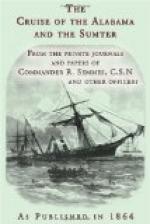if he were an agent. But the bill of lading,
and Davidson’s letter to the consignees, show
that Davidson was both the shipper and the consignor.
The ship was also chartered by Davidson, and 13,000,000
dollars freight-money paid in advance, for which Davidson
required the owner of the ship to secure him by a policy
of insurance against both marine and war risk—the
policy made payable to him (Davidson) in case of loss.
Two questions arise upon that policy: 1st—why,
if the property were bona fide neutral (the
cargo itself was also insured in London) the war clause
should be inserted? and, 2nd—why Davidson
should make the policy payable to himself? If
he advanced this freight money on the credit of the
London house, he had no insurable interest in it;
and if the lumber really belonged to the London house,
and was going to their partners or agents at the port
of delivery, why should Davidson pay the freight in
advance at all? And if Snyder purchased the lumber
of Davidson, why should Snyder not have made the advance
for his principal instead of Davidson? The conclusion
would seem to be, that Davidson was shipping this
lumber on his own account to agents, in whose hands
he had no funds or credit, and as the lumber might
not be sold readily, the ship could not be paid her
freight unless it were paid in advance? Further:
the ship had a contingent destination. She was
either to go to Monte Video or Buenos Ayres, as the
consignees might find most advantageous. This
looks very much like hunting for a market. But
further still. Although Davidson prepared a formal
letter of consignment to Zimmerman, Faris, and Co.,
to accompany the consular certificate, he at the same
time writes another letter, in which he says, “The
cargo of John S. Parks I shall have certified to by
the British Consul as the property of British subjects.
You will find it a very good cargo, and should command
the highest prices.” How is Davidson interested
in the price which this cargo will bring, if it belongs,
as pretended, to the house in London? And if
Davidson sold to Snyder, and Snyder was the agent
of the house in London, Davidson should have still
less concern with it. In that same letter in which
a general account of recent lumber shipments is given,
the following remarks occur:—“Messrs.
Harbeck and Co. have a new barque, Anne Sherwood, in
Portland, for which they have picked up in small lots
a cargo of lumber costing 20,000 dollars. I have
tried to make an arrangement for it to go to you (on
account of John Fair and Co., of London?); but they
as yet only propose to do so, you taking half-interest
at twenty-five dollars, and freight at eighteen dollars,
payable at yours (port?), which is too much. If
I can arrange it on any fair terms, I will do so for
the sake of keeping up your correspondence with H.
and Co.”
[Footnote 14: Extract from a letter, captured on the barque Amazonian, from Mr. Edward F. Davidson to Messrs. Zimmerman, Faris, and Co., of Monte Video:—




